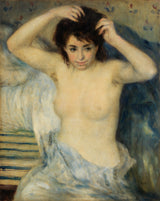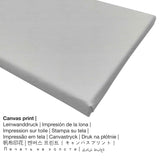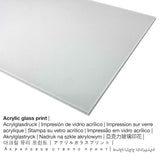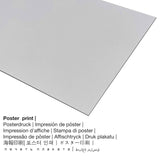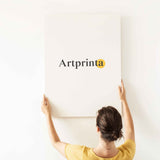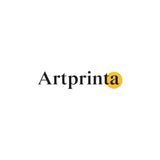Pierre-Auguste Renoir, 1875 - Hamamdan əvvəl (Avant le bain) - təsviri sənət çapı
Vergi daxildir. Göndərmə hesablanıb kasada.
Replikanın xülasəsi
bu müasir incəsənət adlı şah əsəri Before the Bath (Avant le bain) fransız rəssamı tərəfindən hazırlanmışdır Pierre-Auguste Renoir in 1875. Bitdi 140 illik orijinal aşağıdakı ölçülərə malikdir: Ümumi: 32 5/16 x 26 3/16 düym (82 x 66,5 sm). Kətan üzərində yağ was applied by the artist as the medium of the piece of art. This artwork is part of the Barnes Fondu kolleksiya. Nəzakətlə Barnes Fondunun izni ilə, Merion və Filadelfiya, Pensilvaniya (lisenziya - ictimai sahə).: . Bundan əlavə, rəqəmsal reproduksiyanın uyğunlaşdırılmasıdır portret və 1 : 1.2 nisbətinə malikdir ki, bu da onu göstərir uzunluğu enindən 20% qısadır. The illustrator, painter, sculptor Pierre-Auguste Renoir was a European artist, whose art style can be attributed mainly to Impressionism. The European painter was born in the year 1841 in Limoges, Nouvelle-Aquitaine, France and deceased at the age of 78 1919-cu ildə Cagnes-sur-Mer, Provence-Alpes-Cote d'Azur, Fransa.
Barnes Fondu tərəfindən əlavə təsvir (© - Barnes Fondu - Barnes Foundation)
Before the Bath is one of 19 paintings Renoir offered for sale in a scandalous public auction at Hotel Drouot on March 23–24, 1875. Organized by Galerie Durand-Ruel, the auction included new works by Renoir, Monet, Morisot, and Sisley; so controversial were the canvases on view that the public became almost violent. As Paul Durand-Ruel recalled years later, the sale "provoked incredible scenes. The day of the viewing and during the sale, [we] had to call the police in order to prevent small altercations from degenerating into full-fledged battles. The public, incensed by the rare supporters, wanted to stop the sale and howled at each bid". It is hard to imagine that a subtle painting like Before the Bath at one time provoked fistfights. At first glance, it has little of the radicalism of a work such as Study, Nude in Sunlight (Musée d'Orsay), another half-length nude that would cause uproars at the 1876 impressionist exhibition for its bold colors and disruptive splotches of sunlight playing across the flesh. Here, indoors, Renoir's focus is on the body itself rather than on the play of light across it. The moment presented is a private one: the figure undresses for bathing, the shallow space and up-close focus adding to the feeling of intimacy. Her raised arms form a perfect triangular frame around her face, which wears a serene expression. The palette is fairly subdued and the modeling of the figure's torso is strong, with subtle tonal modulations producing rounded forms, especially in the arms and under the breasts. With her sculpted forms and falling garment, she evokes such classical sculpture as the Venus de Milo.This evocation may be precisely what offended about the picture. For superimposed onto this classical frame are signs of the everyday. The hair is unkempt, and rumpled bedcovers can be glimpsed in the background. The raised arms reveal hair in the armpits—a detail which audiences in 1875 were not accustomed to seeing—and the facial features, while attractive, are not idealized: she looks too much like an ordinary Parisian woman. Theodore Duret wrote admiringly about this aspect of Renoir's nudes: "Instead of looking up to beings which represented human nature as perfectly beautiful, he was looking at ordinary creatures, his women were such as one could meet anywhere, he had made no selection." Indeed, it was Duret who had purchased the painting at the 1875 sale, through Henri Hecht, for the small sum of 140 francs. Yet Duret's enthusiasm was hardly typical; for most viewers the painting must have seemed a strange confusion of the real and the ideal.While the painting has the voyeuristic feel of having entered into this woman's private space, we know very well that Renoir set up this scenario in his studio. The patterned wallpaper in the background is from his apartment in the rue Saint-Georges, and can be seen also in the portrait of Jeanne Durand-Ruel (BF950). The model is possibly Henriette Henriot, who posed for so many of Renoir's pictures around this time; see Parisienne (National Museum Wales). Though the hair on this model is darker than the notorious red mane seen in other representations of Henriot, the face, especially the nose and mouth, is strikingly similar to her appearance in Parisienne. By the time Before the Bath was featured in a 1912 exhibition in Durand-Ruel's New York gallery, it was one of Renoir's most celebrated works. Critics such as Octave Mirbeau had earlier praised its "strong drawing," calling it "one of the best pieces of modern painting." Durand-Ruel, who had purchased the painting at the Duret sale in 1894, marveled over the increase in its value over the course of a few decades. Barnes went several times to New York to see the Renoirs in the 1912 exhibition. Struck by this picture in particular, he inquired about its price, only to be told in a letter from one of the Durand-Ruel sons that it was not for sale. Barnes succeeded in securing the picture a few weeks later, in April 1912, much to the delight of American critics such as James Huneker, who raved about its "glowing, nacreous flesh tones [and] its admirable modeling" in the New York Sun. "Luckily," he continued, "the canvas is now in the collection of an American not many hours from New York."
İncəsənət əsəri haqqında strukturlaşdırılmış məlumat
| Əsər adı: | "Before the Bath (Avant le bain)" |
| Əsərin təsnifatı: | rəssamlıq |
| Sənət təsnifatı: | müasir incəsənət |
| vaxt: | 19th əsr |
| ildə yaradılmışdır: | 1875 |
| Əsər yaşı: | 140 yaşdan yuxarı |
| Orijinal sənət mühiti: | kətan yağ |
| Orijinal sənət əsərinin ölçüləri: | Ümumi: 32 5/16 x 26 3/16 düym (82 x 66,5 sm) |
| Muzey / yer: | Barnes Foundation |
| Muzeyin yeri: | Philadelphia, Pennsylvania, Amerika Birləşmiş Ştatları |
| Aşağıda mövcuddur: | Barnes Foundation |
| Lisenziya: | ictimai |
| Nəzakət: | Barnes Fondunun izni ilə, Merion və Filadelfiya, Pensilvaniya |
Rəssamın xülasəsi cədvəli
| Rəssamın adı: | Pierre-Auguste Renoir |
| Əlavə adlar: | renoir p.a., Pierre Auguste Renoir, Renoir Pierre-Auguste, Renuar Ogi︠u︡st, רנואר פייר אוגוסט, Renoir August, Renoir Auguste, p.a. renoir, renoir a., firmin auguste renoir, a. renoir, Renoir Pierre Auguste, Renoir Pierre August, Renoar Pjer-Ogist, רנואר אוגוסט, August Renoir, Auguste Renoir, Renoir, pierre august renoir, Pierre-Auguste Renoir |
| Gender: | kişi |
| Rəssamın milliyyəti: | Fransız |
| Rəssamın peşələri: | heykəltəraş, illüstrator, rəssam |
| Mənşə ölkəsi: | Fransa |
| Rəssam kateqoriyası: | müasir rəssam |
| İncəsənət üslubları: | İmpressionizm |
| Ölüm yaşı: | 78 il |
| Doğulduğu il: | 1841 |
| Doğulduğu şəhər: | Limoges, Nouvelle-Aquitaine, Fransa |
| Vəfat ili: | 1919 |
| Ölüm şəhəri: | Cagnes-sur-Mer, Provence-Alpes-Cote d'Azur, Fransa |
Sevdiyiniz məhsul materialını əldə edin
Hər bir məhsul üçün müxtəlif ölçülər və materiallar təklif edirik. Biz sizə aşağıdakı variantlardan seçim etməyə imkan veririk:
- Akril şüşə üzərində çap (əsl şüşə örtüyü ilə): The print on acrylic glass, often referenced as a UV print on plexiglass, will turn the original into gorgeous wall décor and is a good alternative to aluminium and canvas fine art prints.
- Plakat (kətan materialı): The poster is a UV printed sheet of flat canvas paper with a nice surface finish, that resembles the original masterpiece. It is ideally suited for putting the art print in a customized frame. Please note, that depending on the size of the poster we add a white margin of something between 2-6cm around the print, which facilitates the framing with a custom frame.
- Alüminium dibond: This is a metal print manufactured on aluminium dibond with an outstanding depth effect. The non-reflective surface structure make a fashionable impression. The Direct Print on Aluminum Dibond is your excellent start to the sophisticated world of art replicas on aluminum.
- Kətan: The printed canvas material stretched on a wood frame. The advantage of canvas prints is that they are relatively low in weight, meaning that it is easy and straightforward to hang up the Canvas print without additional wall-mounts. A canvas print is suitable for all types of walls.
Strukturlaşdırılmış element detalları
| Məhsul təsnifatı: | təsviri sənət çapı |
| Reproduksiya: | rəqəmsal formatda reproduksiya |
| İstehsal üsulu: | UV birbaşa çap (rəqəmsal çap) |
| Məhsulun mənşəyi: | Almaniya |
| Ehtiyat növü: | tələb əsasında istehsal |
| Təklif olunan məhsulun istifadəsi: | divar sənəti, sənət kolleksiyası (reproduksiyalar) |
| Şəklin istiqaməti: | portret formatı |
| Yan nisbət: | 1: 1.2 uzunluqdan enə |
| Şəklin aspekt nisbətinin təfsiri: | uzunluğu enindən 20% qısadır |
| Seçə biləcəyiniz materiallar: | kətan çapı, metal çap (alüminium dibond), poster çapı (kətan kağızı), akril şüşə çap (əsl şüşə örtüklü) |
| Kətan çapı (xərəyə çərçivədə kətan) ölçü variantları: | 50x60sm - 20x24", 100x120sm - 39x47", 150x180sm - 59x71" |
| Akrilik şüşə çap (əsl şüşə örtüklü) ölçüləri: | 50x60sm - 20x24", 100x120sm - 39x47" |
| Poster çapı (kətan kağızı): | 50x60sm - 20x24", 100x120sm - 39x47" |
| Alüminium çap (alüminium dibond materialı) ölçü seçimləri: | 50x60sm - 20x24", 100x120sm - 39x47" |
| Bədii çap çərçivəsi: | daxil deyil |
Əhəmiyyətli hüquqi qeyd: We try whatever we can in order to depict our products as accurately as it is possible and to exhibit them visually in our shop. Still, the pigments of the printed materials, as well as the print result might differ slightly from the presentation on the monitor. Depending on the settings of your screen and the nature of the surface, colors might not be printed one hundret percent realistically. Since all our art reproductions are printed and processed by hand, there might also be slight deviations in the exact position and the size of the motif.
Bu mətn müəllif hüquqları ilə qorunur © - www.artprinta.com (Artprinta)

